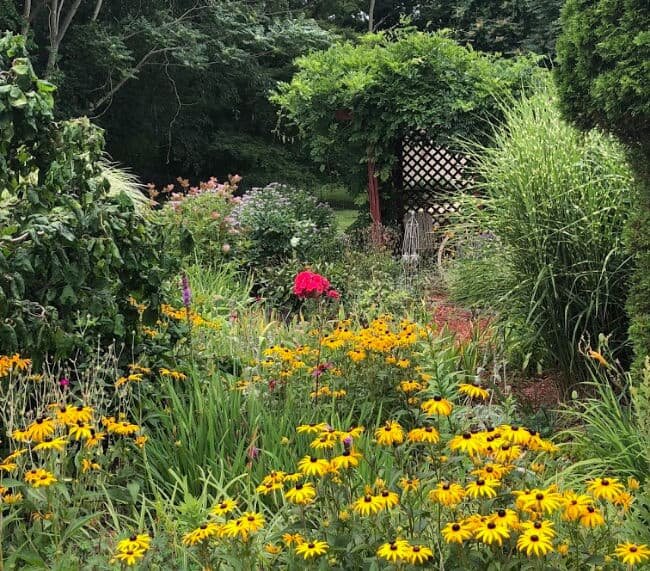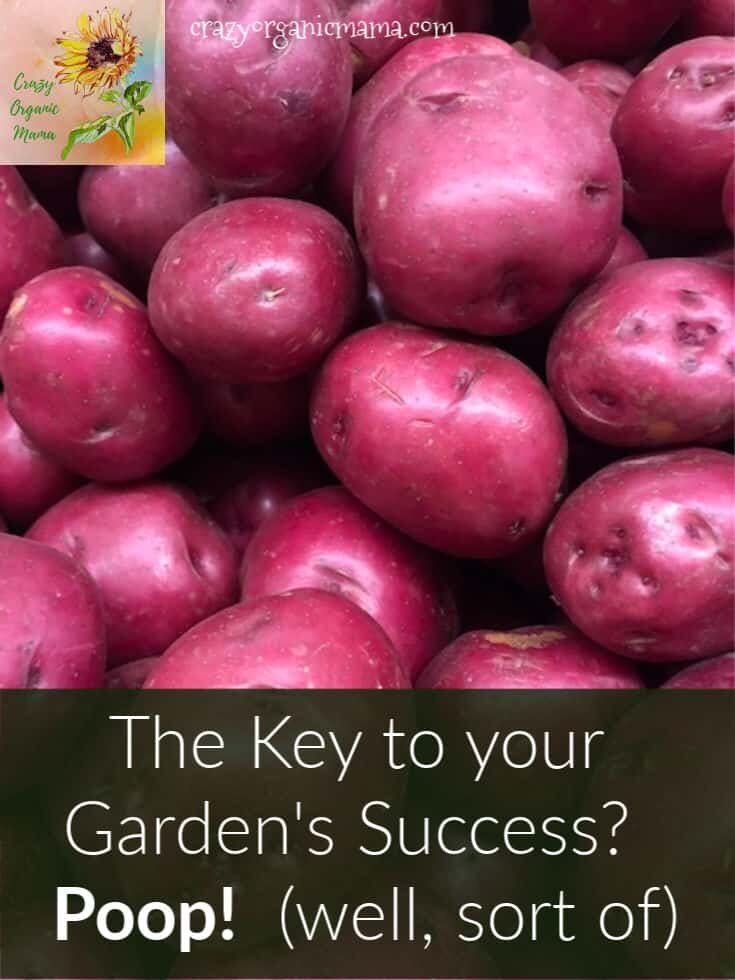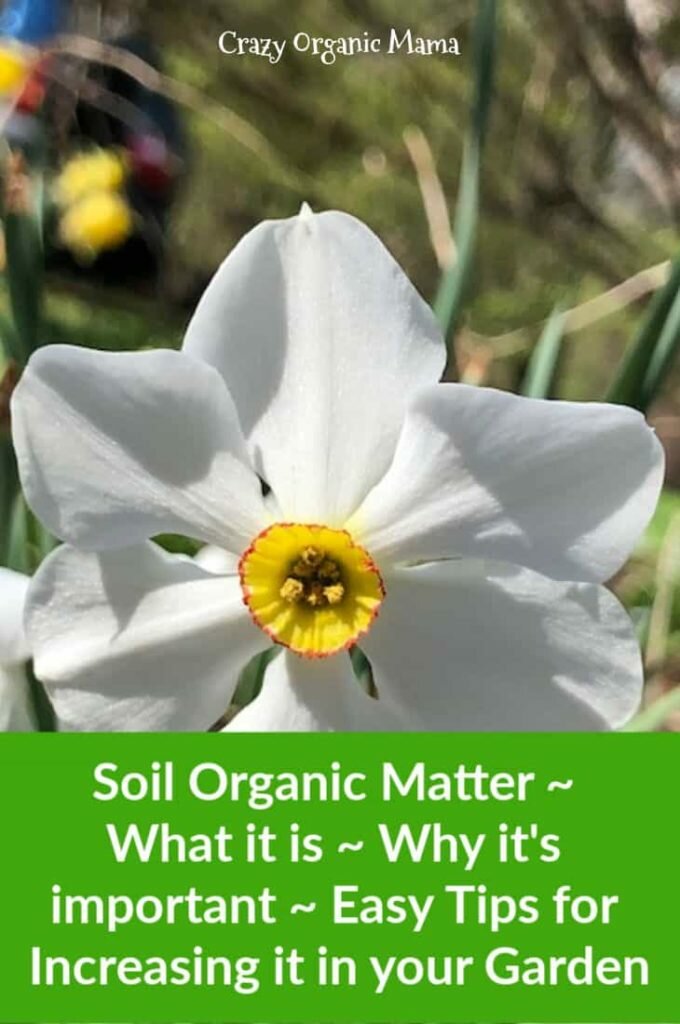Soil Organic Matter is THE key to your Garden’s Health
How important is soil organic matter? Well, in short, your plants need it and if they don’t have it, they ain’t growing.
So, let’s take a deep breath and dive in. I hope the water is nice and warm, I get cold easily. How about you?
What is soil organic matter?
Simply put, OM (remember, that’s organic matter to the uninitiated) in the soil is anything living or the remains of anything that was once living in the soil, whether they be plants, animals or the little bitty critters you’re never even aware are there (and they outnumber all the other stuff by a whole lot!)
Because all living things contain carbon, it comprises a large percentage of OM, although there’s a fair amount of nitrogen in certain types as well.

Organic Matter and Soil Structure
OM has a lot to do with the structure of the soil. What I mean by this is, let’s say you go out to your garden the day after it’s rained (this won’t work in the winter where it’s cold, I’m talking about during the growing season). Grab a handful of soil and squeeze, then open your hand.
Does it stick together in a hard ball or does it immediately crumble and fall from your hand? Neither of these is desirable. The first indicates a clay soil, the second a sandy soil. Both can benefit from more organic matter.
You want the soil to form a loose, kind of crumbly ball in your hand. This is loam, the kind of soil best suited to growing the largest variety of plants.
Plants need pores in the soil for their roots to grow and access nutrients, water and air, and well-structured soil has lots of these. And, yes, plant roots need air, that’s why plants submerged in water or watered too heavily often die .
This post contains affiliate links. When you make a purchase through one of these links, I earn a small commission. This does not affect your purchase price.
Soil Organic Matter and Nutrients
The other important thing OM does is release nutrients for the plants to use. Remember the carbon from earlier? It has lots of friends in OM, things like nitrogen, potassium, phosphorus, iron, and others.
The organisms in the OM also convert certain of these nutrients into a usable form for the plant. OM also holds onto these nutrients in such a way that the plant roots can access them before they get washed away or volatilized.
Volatilization is a big fancy term for when nitrogen changes from a solid to a gas. That’s why you smell manure REALLY strongly right after a field is fertilized, the nitrogen is changing and escaping into the air.
We’ll talk about ways you can reduce volatilization later in this post. It’s not hard. And you should DEFINITELY try to work that word into a conversation this week, don’t you think?

These are the plants that produced 315 lbs of tomatoes one summer.
Soil organic matter can be your best friend!
Where does organic matter come from?
So, I’m convinced OM is important, you say. Now how do I get it into my garden?
Here’s how:
Getting Organic Matter into your Garden
You actually have a couple of options. The first and simplest is to go to your local garden center and buy compost. You really want to buy organic compost.
Because animals eat forage (grasses and even weeds in fields) and their feces (ya know, their poop, I’m trying to be fancy here, ok?) are used to make the compost, if the fields aren’t managed organically, weed killers can pass through the animals’ bodies into their poop (ok, I gave up, it’s poop). This poop is then used as a component in the compost.
Even though it has been through the composting process, it’s been found that some weed killers can make it through the process intact enough that when the compost gets applied to your crops, guess what? You just applied weed killer to your plants! WOO HOO! Dead plants, poison in the soil, little things like that.
Buy organic compost.

What Not to Do…and why
Another caution: Don’t go to a farm, ask the farmer for his horse/cow/chicken/pig/llama manure and come home and slap it on the garden you’re planting veggies in next week. This is a bad idea for several reasons.
ONE, EWWWW!!!! There’s bacteria in animal poop (yes, even llama!) that you don’t want to take a chance of getting on or in your food crops. Plus, how would you like to go out and weed in soil full of animal poop? Nope!
TWO, your neighbors will hate you, particularly if you choose pig or chicken poop (not sure on the llama, never experienced that). This stuff SMELLS, particularly if you don’t work it into the soil thoroughly.
And remember I said I was going to give you a tip to reduce volatilization? Here it is:
Whatever compost you do end up with, mix it thoroughly into the soil, don’t just spread it on top. It won’t volatilize nearly as much when it’s mixed in.
A bonus tip: Don’t fertilize in the fall. You’ll lose a lot of nutrients over the winter when nothing is growing, but water is still leaching the nutrients down and out of the soil. Plants are what help hold the nutrients in the soil.
THREE, animal matter of any sort is mostly carbon. When you put it on your garden in its raw form in the absence of anything containing nitrogen, the microorganisms that break it down tie up the nitrogen in the soil in order to perform their job. Since plants really need that nitrogen, it’s a bad thing.
If you’re really in love with the idea of spreading raw animal manure on your garden, and if so, I’m pretty sure there’s something wrong with you, this is the one time you would want to apply it ahead of time. Like, WAAAAAY ahead of time.
Raw animal manure needs 6 months to break down to a safe form in the soil and stop holding onto all that nitrogen. Keep in mind that in the colder climates, breakdown slows down to almost nothing in the winter, so you pretty much need a full year to make sure it’s broken down adequately. Not really worth the aggravation.
What you Should be Doing
Option 1: Buy Compost
It is a little more expensive to go to the garden center and buy compost, but the compost you buy has both carbon (from animal sources) and nitrogen (from plant sources) in it, and you don’t have to worry about waiting periods or anything else. You can bring it home, mix it in and start planting.
It doesn’t smell bad (in fact, I think it smells really good, clean and earthy) and there is no bacteria because of the way it’s processed. I personally really like the composts that contain seaweeds and lobster, but any organic compost is going to be good.

Option 2: Make your Own
As a second option, you can, if you don’t want the expense of buying compost, make your own. I can’t go into that in this post, it is a broad and complex subject well-suited to multiple other posts (some other time, I promise!).
You can also find multiple resources online (here is one) if you want to give it a try. The article I linked to is long, but quite informative.
One caution: The article talks about putting worm bins outside. If you live where winters get below freezing, don’t try to put composting worms outside in the winter. They need temperatures above freezing. I have my worm composter indoors. You can read about my worm composting efforts here.
BONUS: Other techniques for building and maintaining organic matter in your soil
Technique 1: No-till
There are multiple other ways you can build and maintain the organic matter in your soil. One of the most important is to maintain a no-till garden. What this means is, you don’t take that nasty old rototiller into your vegetable garden every spring and dig the whole thing up.
In fact, you might as well sell it to someone who doesn’t know better and use the money to buy plants, because you should never, ever, EVER use one again. This is probably the worst thing you could EVER do to your soil!
Why No-till?
Remember how we talked about all those pores in healthy soil? Tilling smashes these pores and compresses the soil, not something you want.
Just a little example of what you DO want: I visited a farm several years ago where the farmer worked very hard at building and maintaining his soil. We went out into one of his fields and he plunged his arm up past his elbow almost to his shoulder into the soil. There was no resistance, he didn’t even have to work at it. He gets an A+ for soil health!

What you Can do Instead
That’s not to say you can’t ever go out and hoe your garden or pull weeds. You can certainly do that (if you really want to!), but do it by hand or with handheld equipment, if at all possible.
Even the action of taking power equipment across the soil or walking repeatedly on planting areas damages the soil structure and should be avoided as much as you can.
Technique 2: Cover crops and Green manures
There are other options for keeping your soil healthy, the details of which I’ll get into in another post or two (or three!) Here’s one to start on: No-Till Gardening: Making it Work for You. Quickly, though, green manures and cover crops are great for both building nutrients in the soil and helping to hold those already present.
Technique 3: Crop Rotation
Crop rotation, where you grow different crops each year in an area (say, tomatoes one year, then squash in that spot the next year) also help keep nutrients from getting depleted, as well as guard against soil diseases.
Technique 4: Permaculture
Lastly, permaculture, a method of planting that incorporates trees, bushes, vines, plants, and ground covers that aren’t harvested yearly, can contribute to soil health and to environmental health as a whole.
It is a bit more complicated than the other techniques, but can have big payoffs in terms of the health of your garden ecosystem as a whole.
Why You Want Healthy Soil: A real-life Example

Just a closing remark in support of what I’ve been saying: My mom LOVES Florida oranges but won’t even buy the ones from California (no offense, Californians!). She says the West Coast ones have no flavor, but for whatever reason, it’s tough to get Florida oranges around here.
It took me awhile to figure out why she liked one and not the other because she always buys navels. Therefore, they should taste the same, n’est-ce pas? (That’s my fancy French way of saying you should agree with me.)
Anyway, I finally had an inkling of the problem so I bought her some organic navels from CA….and she said they were really good.
AH-HA!!
Sorry, did I startle you? I saw you nodding off there behind your computer and figured I’d wake you up!
So what did I figure out, you ask? I’ll tell you! It was the SOIL that made the difference! You see, the soil on conventional citrus (or other) farms in California has likely gotten depleted of nutrients, so farmers are adding synthetic fertilizers (because they’re cheap and easy. The fertilizers, not the farmers….I know you were thinking it!).
Much of CA is also really dry, so they’re irrigating constantly to keep the trees alive, which causes another whole host of problems (not for this post).
FL has much more rainfall than CA, thus less irrigation, and I believe the soil there is probably richer in organic matter to begin with, as East Coast soil types tend to be.
By buying ORGANIC navels from CA, I was buying oranges that had been grown in healthier, more nutrient-rich soil. Not only would the soil have been enriched with natural amendments such as compost, but healthy soil would not require nearly the amount of water as unhealthy soil, solving the irrigation issues as well.
Voila! Healthy soil = better-tasting food! What could be better (or simpler) than that??
Posts Related to Soil Organic Matter
- Indoor Worm Composting
- Tips for Beginning Gardeners
- Planning Tips for your Spring Garden
- No-Till Gardening: Making it Work for You
If you’re not yet an email subscriber, head over here and sign up. I promise never to spam you (it’s icky and makes me nauseous!), but you will receive a weekly newsletter with new happenings around the blog. You’ll also get INSTANT access to ALL THE FREEBIES in my Subscribers Only Resource Library. I add to it regularly, so you don’t want to miss out!
With that, I will close this very long, but hopefully informative, post. You’ll find some additional resources below. Please also remember to pin the pictures below on Pinterest for future reference.
As always, keep smiling, feel free to leave me some comment love, and have a crazy organic day!
Additional resources:
The Soul of Soil by Gershuny & Smillie. Very interesting and accessible, even for the beginner. Buy it here.
The Nature and Properties of Soils by Brady & Weil. Warning: This is a textbook of more than 1000 pages. It has great information, but it’s a real handful! Buy it here. (I have the 14th edition. The 15th edition is the current one, but the updates are probably not worth the cost difference).
Soil Fertility and Fertilizers by Havlin, Tisdale, Nelson & Beaton. Again, a textbook but this one is only 500 pages! I found it an easier read than the Brady & Weil book. Buy it here.



Why Soil Organic Matter is Vitally Important to your Garden’s Health



2 comments
Awwww man there goes my horse manure business lol I was wondering how long the manure needed to breakdown before it was a benefit 🙂
Hahaha! Yeah, it takes awhile. If you live where it stays warm in the winter, you could mix it in in the fall and plant in the spring but I would be leery of doing it that fast anywhere the winters get below freezing because it’s just not going to break down fast enough.